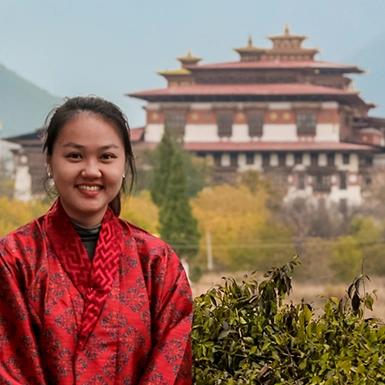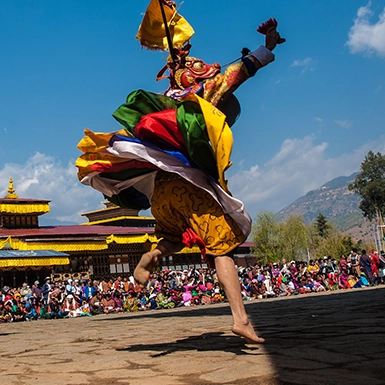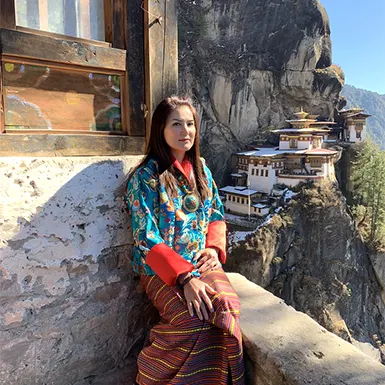Based on 746 reviews

Bhutan Holiday Packages
Exploring the Dragon Kingdom: A Journey Through Bhutan
Duration
Meals
- 7 Lunch
- 7 Dinner
- 7 Breakfast
Accommodation
Paro – Mandala Resort
Thimphu – Hotel Pedling
Punakha – Hotel Vara
Activities
- Sightseeing
- Trekking
- Scenic Drive/Flight
SAVE
€ 510Price Starts From
€ 2550
Overview of Bhutan Holiday Packages
Nestled in the Eastern Himalayas, Bhutan has gradually welcomed the world after centuries of seclusion, establishing itself as a pristine choice for Bhutan Holiday Packages. This captivating kingdom, home to approximately 700,000 people and spanning an area similar to Switzerland, harmonizes its environment and people to craft a distinctive identity deeply rooted in rich religious and cultural traditions. Bhutan uniquely prioritizes Mahayana Buddhism as its principal religion, and its dedication to the Buddhist ethos of compassion safeguards its unspoiled landscapes and abundant biodiversity.
Explorers visiting Bhutan encounter a diverse and beautiful array of tourist destinations. The majestic Taktshang Monastery (Tiger’s Nest), clinging to a Paro cliff, and the tranquil Punakha Dzong, at two rivers’ confluence, offer insights into the kingdom’s soul. Their architecture and sanctity mirror Bhutan’s profound Buddhist heritage.
Trip Highlights
- Trek to Paro’s Taktshang Monastery (Tiger’s Nest) – Start an exhilarating hike to the iconic monastery perched on a cliff, offering breathtaking panoramic views and a profound spiritual journey.
- Sightseeing in Thimphu – Delve into the blend of contemporary and traditional life in Thimphu with stops at the majestic Buddha Dordenma Statue, the historic Tashichho Dzong, and the revered National Memorial Chorten.
- Exploration of Punakha Dzong – Witness the stunning Punakha Dzong, which reflects Bhutan’s rich cultural legacy and stands at the meeting of two rivers.
- Journey through Dochula Pass – Take in the stunning vistas of the Himalayas and the peaceful ambiance created by 108 chortens that dot the landscape.
- Visit Phobjikha Valley – Revel in the serene beauty and natural wonders of this glacial valley, winter home to the rare black-necked cranes.
- Adventure to Haa Valley – Venture off the beaten path to explore the cultural treasures and scenic beauty of the Haa Valley.
- Local Village Cultural Experience – Visit traditional villages to get a sense of the way of life in Bhutan and learn about the customs and traditions of the people there.
In the capital city, Thimphu, visitors can dive into Bhutan’s contemporary life while connecting with its ancient roots. The National Memorial Chorten, Thimphu Dzong (Tashichho Dzong), and the Buddha Dordenma Statue symbolize the country’s fusion of tradition and modernity.
A journey through Bhutan’s landmarks must include the Phobjikha Valley, a glacial valley along the Black Mountains’ western slopes. Renowned for its breathtaking beauty and the endangered black-necked cranes that winter there, Phobjikha underscores Bhutan’s dedication to conservation.
Bhutan’s historical narrative fascinates equally, with the esteemed Indian sage Padmasambhava introducing Buddhism in the 8th century. Zhabdrung Ngawang Namgyal’s arrival in the 17th century, uniting the nation and establishing its governance and identity, marked a significant era. The election of Gongsar Ugyen Wangchuck as Bhutan’s first king in 1907 initiated the renowned Wangchuck dynasty. The fourth king’s decision in 2006 to transition to a constitutional monarchy with a parliamentary democracy, followed by the crowning of Jigme Khesar Namgyel Wangchuck in 2008, showcases Bhutan’s gradual integration with the global stage while maintaining its unique heritage.
Bhutan Holiday Packages presents a close encounter with the kingdom’s mystical allure, from its grand fortresses and monasteries to its stunning natural scenery. Destinations within Bhutan, ranging from the iconic Paro to the peaceful Thimphu and the lush valleys of Punakha and Phobjikha, offer a variety of experiences for travelers seeking tranquility, spiritual growth, and natural beauty.
Detail Itinerary of Bhutan Holiday Packages
Day 01: Gateway to Bhutan - Arrival in Paro & Drive to Thimphu (55 km / 1.5 hrs)
Landing in Paro unveils the Himalayas’ spectacular views as the descent from Kathmandu into Bhutan mesmerizes you. The mountain’s fresh, cool air greets you upon exiting the plane.
After clearing immigration and collecting your luggage, our representative will escort you to Thimphu, Bhutan’s capital. The drive features a stop at Chuzom, where the Thimphu and Paro rivers meet, adorned with Tibetan, Nepalese, and Bhutanese stupas.

When Balaha, the good horse, a manifestation of Chenrezig, visited this location in the fifteenth century, a private temple known as Tschogang Lhakhang, or “the temple of the excellent horse,” welcomed you. Close to Chuzom is its location.
You check into your hotel as soon as you get to Thimphu. Thimphu, blending modern development with ancient traditions, serves as the epicenter of Bhutan’s government, religion, and commerce. Remarkably, it probably remains the world’s only capital city without traffic lights despite its population nearing 90,000.

In the evening, you explore Thimphu’s Main Street and market area, immersing yourself in the local culture. Additionally, you visit the Local Crafts Bazaar to learn about the magnificent traditional arts of Bhutan, which include jewelry, ceramics, slate and wood carvings, masks, hand-woven textiles, Thangkha paintings, and other one-of-a-kind things made from local materials.
After an overnight stay at a hotel at 2400 meters above sea level in Thimphu, the day concludes.
Accommodation: Hotel Pedling or a similar 3-star hotel
Meals: Lunch and Dinner
Day 02: Thimphu's Cultural Immersion
After breakfast, you will start a sightseeing tour of Thimphu. Your journey starts at Changangkha Lhakhang, a fortress-like temple and monastic school perched above Thimphu, established in the 12th century by Lama Phajo Drugom Shigpo from Tibet.

The temple houses an 11-headed Chenrezig statue, providing a magnificent view of the Thimphu valley.
You visit the Takin Preserve next, home to the Takin, Bhutan’s national animal, a unique species said to have been created by the Buddhist yogi Drupa Kunley. The Takin, which resembles both a cow and a goat, is exclusive to Bhutan and nearby regions and falls into its unique taxonomic category.
Trashichhoe Dzong, a fortress/monastery, houses the Secretariat, His Majesty the King’s throne room, and other government offices. It also serves as the Chief Abbot’s summer residence and the headquarters of the monk body. After that, you explore the complex.
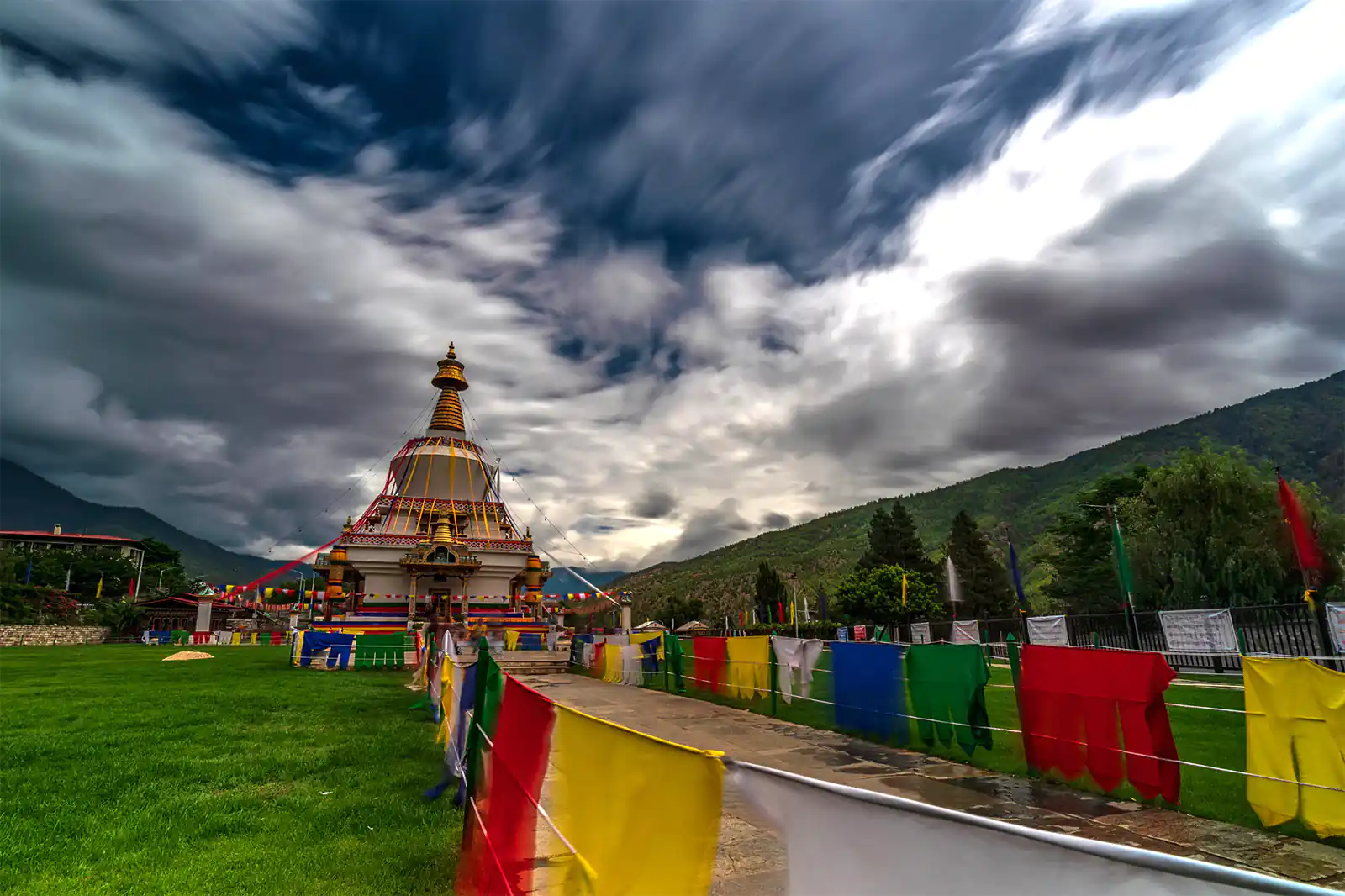
Following that, you go to the monarch’s Memorial Chorten, a memorial to global peace and prosperity designed by His Majesty Jigme Dorji Wangchuk, the third monarch of Bhutan, and perpetually surrounded by people reciting mantras and turning prayer wheels. Completed in 1974 following his death, it now memorializes the Late King and stands as a peace monument.
Your tour concludes at Buddha Point (Kuensel Phodrang), a brief drive from Thimphu’s center. Here, you can view the Thimphu Valley, offer prayers at the country’s largest Buddha statue, and enjoy the panoramic scenery.
Your exploration ends with another night at a hotel in Thimphu.
Accommodation: Hotel Pedling or a similar 3-star hotel
Meals: Breakfast, Lunch and Dinner
Day 03: Journey Through the Mountains - Thimphu to Punakha (75 km / 3 hrs)
Enjoy breakfast at your hotel, then depart for Punakha, crossing the Dochula Pass (3080m) adorned with large Bhutanese Chorten and prayer flags. The pass offers stunning views of the eastern Himalayas’ towering peaks on a clear day.
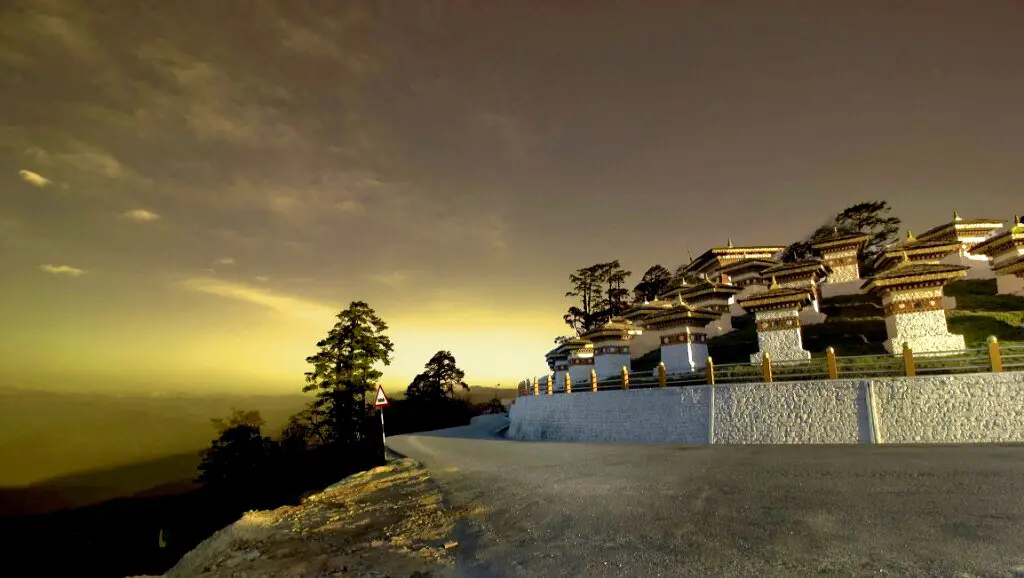
After checking into your Punakha hotel, visit the majestic Punakha Dzong, situated where two rivers merge. Once the capital of Bhutan until 1955, the dzong now hosts the monk body during winter. In the afternoon, you’ll head to Chimi Lhakhang after a 15-minute drive from the hotel.
The walk through paddy fields and villages to the fertility temple on a valley hillock takes about 1.5 hours round trip. Believed to bless childless couples with children, the journey through Pana village offers a glimpse into local life.
The evening provides a chance to explore Punakha village by the river.
The day ends with an overnight stay at a hotel in Punakha.
Accommodation: Hotel Vara or a similar 3-star hotel
Meals: Breakfast, Lunch and Dinner
Day 04: Exploring Punakha's Natural and Historic Sights
Start with breakfast, then hike along the Mo Chhu through chili, cabbage, and rice fields to Khamsum Yuelley Namgyal Chorten, a beautiful monument the Queens commissioned and blessed in 1999.
Then, travel to the Sangchhen Dorji Lhuendrup Lhakhang Nunnery, which is situated amidst pine trees on a ridge and offers views over the Wangdue Phodrang and Punakha valleys. The nunnery is home to a fourteen-foot bronze statue of Gautama Buddha, Guru Padma Sambawa, and Avalokiteshvara (Chenrigzig reciting and talking).
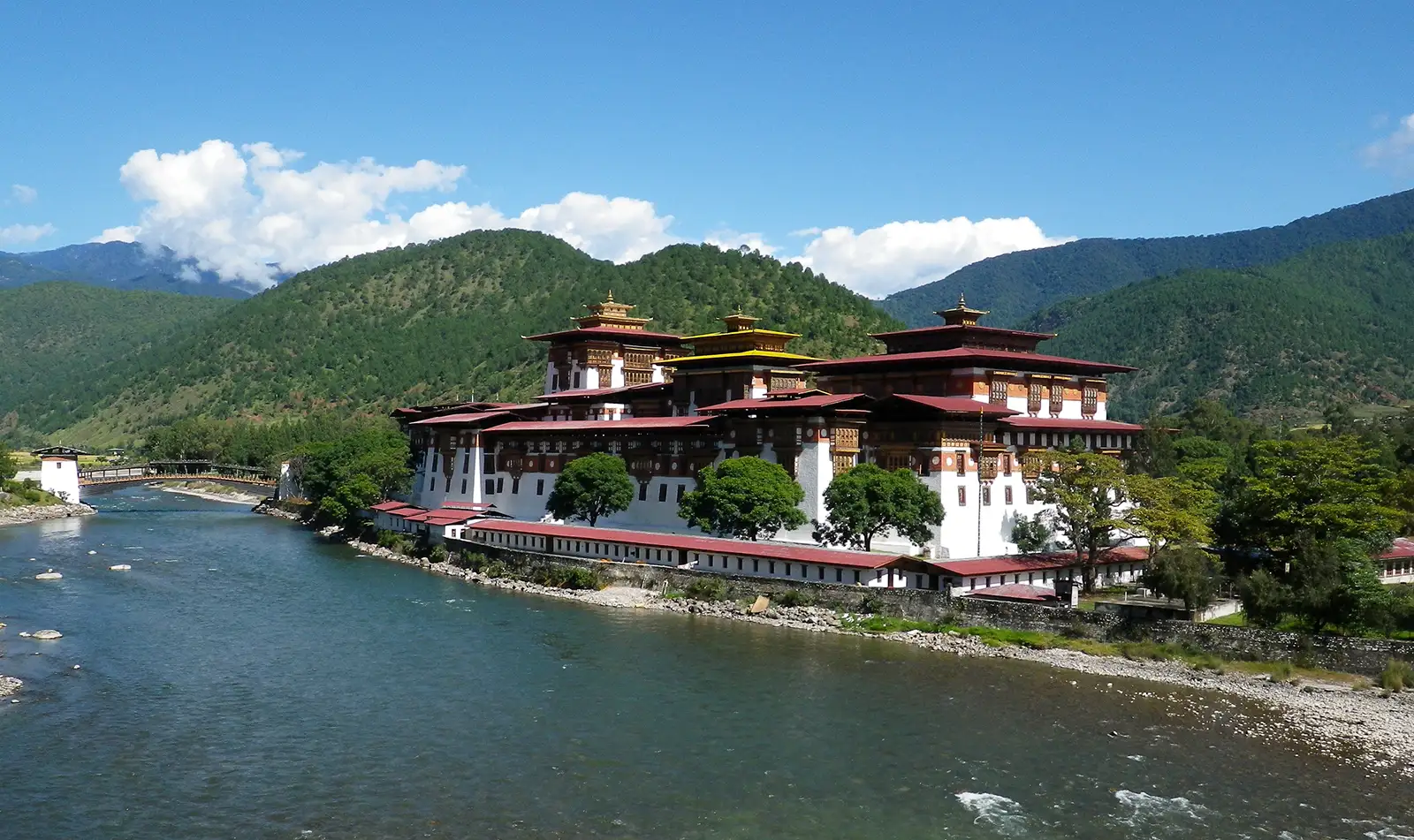
Local artisans crafted this significant statue, one of the largest in Bhutan. The complex offers training in religious practices and practical skills like tailoring, needlework, statue construction, and thangka painting. It also functions as a center for higher learning and meditation for nuns.
Your stay in Punakha concludes with another night at the hotel.
Accommodation: Hotel Vara or a similar 3-star hotel
Meals: Breakfast, Lunch and Dinner
Day 05: Return Journey to Paro - The Valley of Sacred Sites (120 km / 4.5 hrs)
Enjoy breakfast before departing your hotel for the scenic drive to Paro, making a stop to explore Simtokha Dzong on the way. Established in 1627, this historical fortress, the oldest in Bhutan, currently functions as a School for Buddhist Studies.
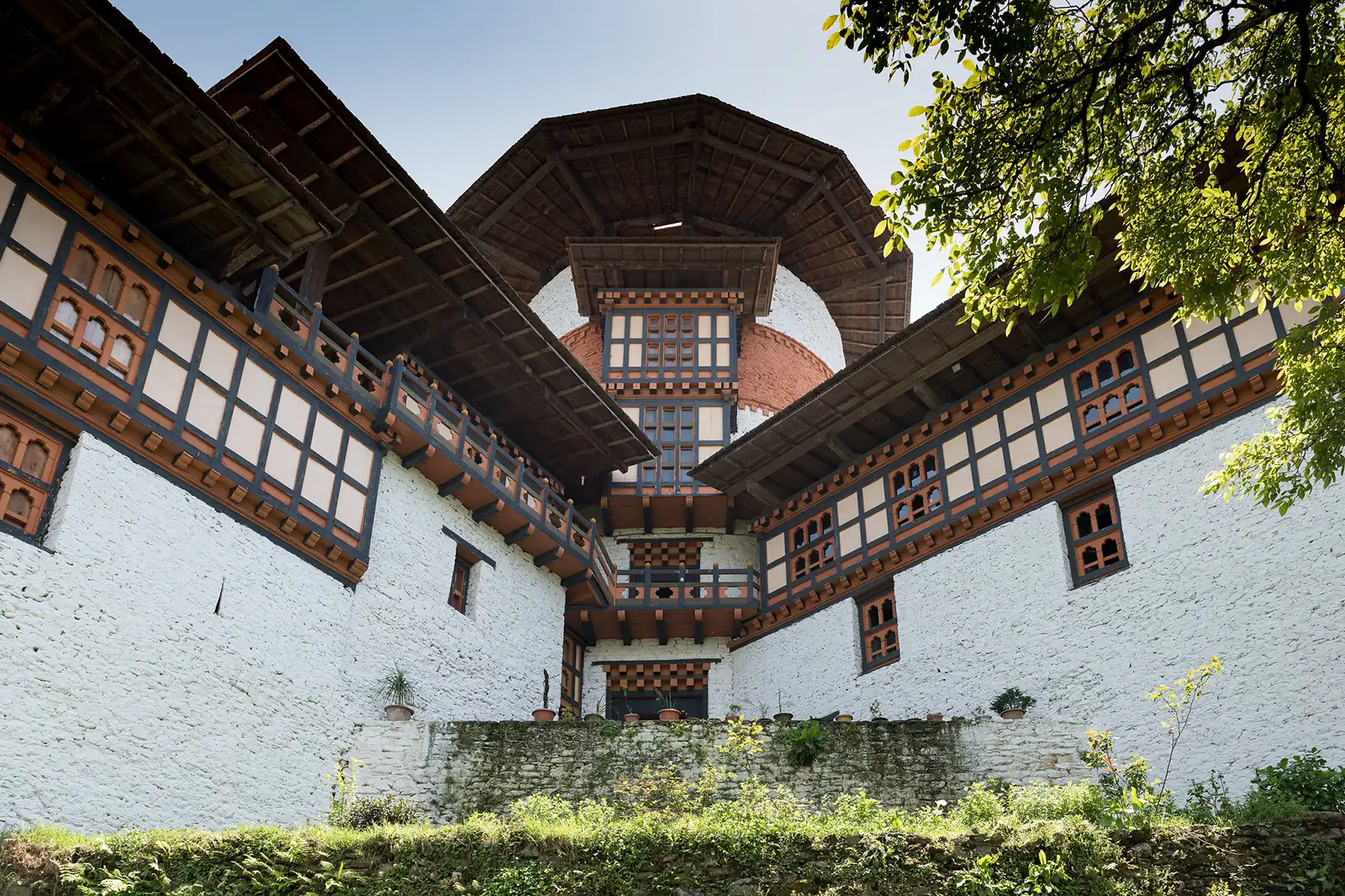
Upon your arrival in Paro, proceed to check into your hotel. After enjoying lunch, visit Ta Dzong, once a defensive watchtower, now repurposed as the National Museum. This museum showcases a comprehensive collection that includes antique Thangkha paintings, textiles, weapons, and armor, along with a wide variety of household and historical items.
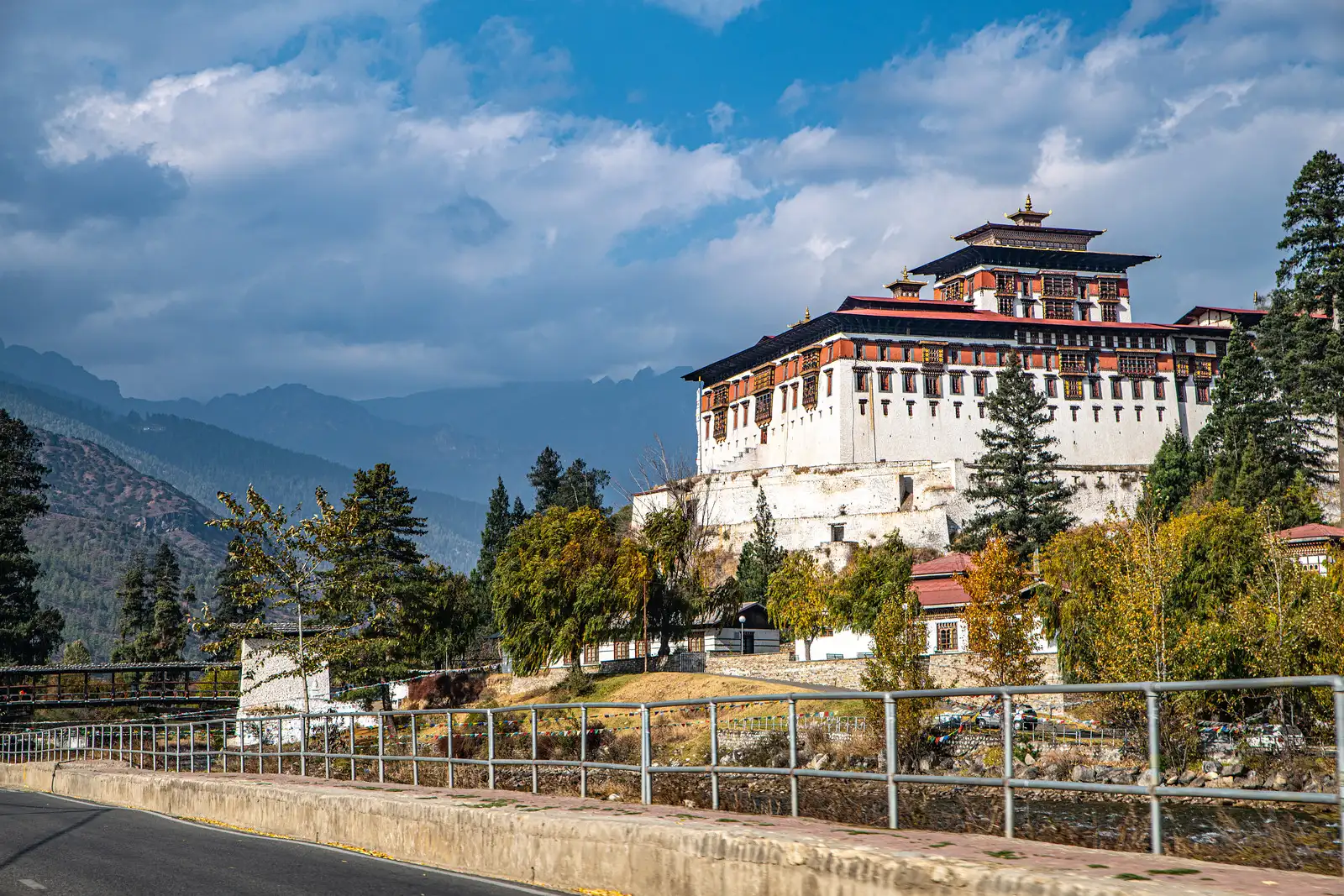
Next, a short walk from Ta Dzong leads you to Rinpung Dzong (Paro Dzong), aptly named the “fortress of the heap of jewels” and celebrated for its rich history. Its inner courtyard’s wooden galleries display beautiful wall paintings depicting stories from Buddhist traditions, such as the four friends, the older man of long life, the wheel of life, and tales from the life of Milarepa.
End the day with an overnight stay at a hotel in Paro.
Accommodation: Mandala Resort or a similar 3-star Resort
Meals: Breakfast, Lunch and Dinner
Day 06: Trek to the Tiger's Nest - Paro's Iconic Pilgrimage
Kick off the day with breakfast, then start a 5-hour trek to Taktsang Monastery, or Tiger’s Nest, spectacularly perched on a cliff 900m above the Paro valley.
Famed for Guru Rinpoche’s meditation after arriving on the back of a tigress, this monastery, visited by Shabdrung Ngawang Namgyal in 1646, is a sacred site every Bhutanese strives to visit at least once.
After a severe fire damaged it in 1998, restoration efforts have beautifully returned it to its original splendor.
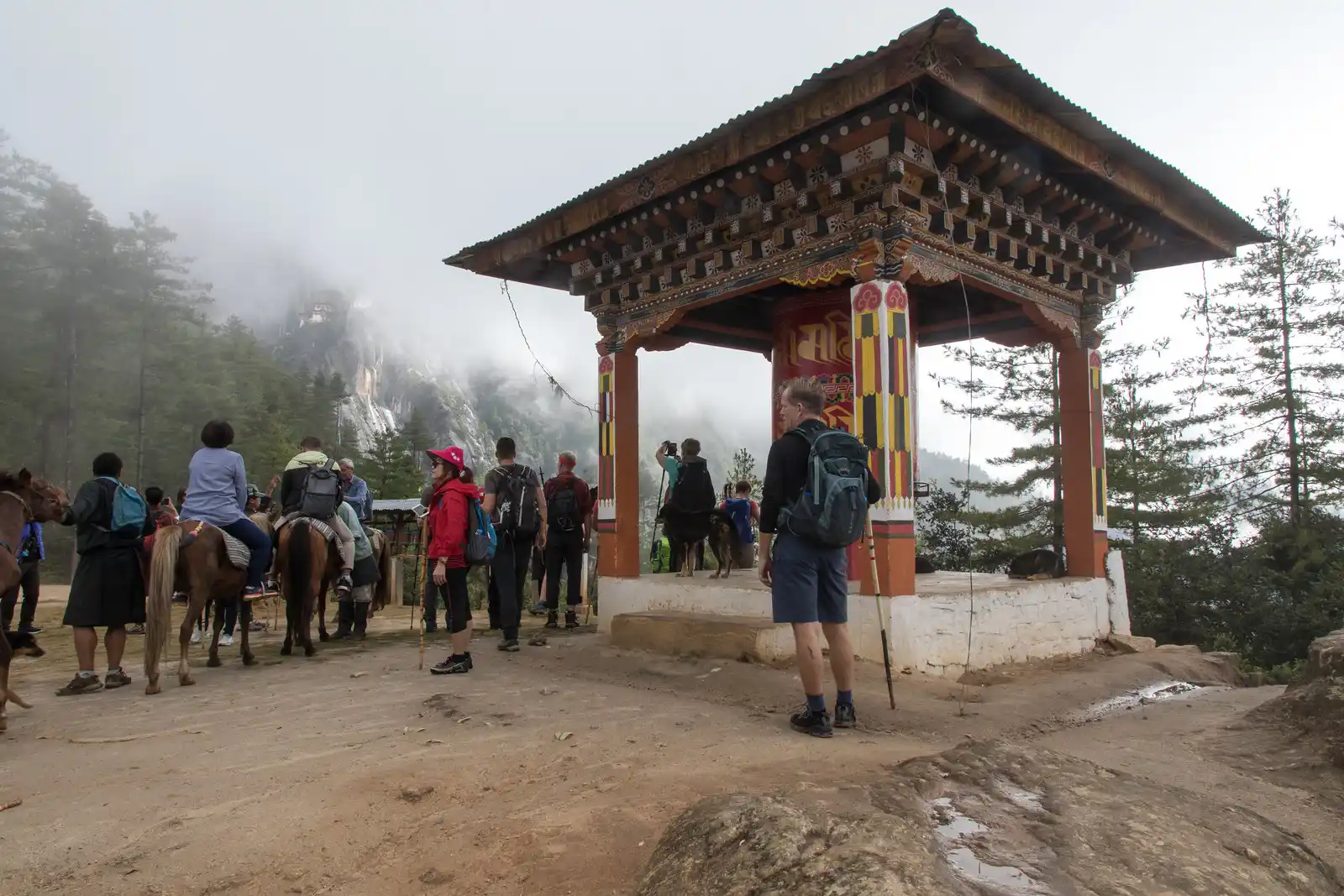
In the afternoon, take a trip to Drukgyel Dzong, the site of ancient battles between Bhutanese warriors and Tibetan invaders, offering magnificent views of Chomolhari from the approach road.
Evening brings a visit to Kyichu Lhakhang, a 7th-century temple founded by Tibetan King Songtsen Gampo. As one of the 108 temples constructed across the Himalayas, it marks the spread of Buddhism into Bhutan.
The exploration concludes with another night at a hotel in Paro.
Accommodation: Mandala Resort or a similar 3-star Resort
Meals: Breakfast, Lunch and Dinner
Day 07: Adventure to the Haa Valley - A Hidden Gem (Day Trip)
After breakfast, depart for a visit to the stunning Haa Valley, one of the most picturesque locations in the kingdom, with an area of 1706 square kilometers and borders the districts of Paro, Chhukha, and Samtse.
The people who lived in the Haa Valley used to be animists, and they would sacrifice animals’ blood to the local gods.
However, Guru Padmasambhava transformed this tradition into a peaceful Buddhist one in the 8th century, subduing local deities like Ap Chundu.

At the same time, traces of the ancient belief system still manifest through festivals and rituals.
Foreign tourists gained access to Haa Valley for the first time in 2002, revealing its rich cultural heritage. Nestled near the foothills of the sacred Meri Puensum mountain range, two notable sites are the 7th-century Lhakhang Karpo (White Temple) and Lhakhang Nagpo (Black Temple).
Highlight Haa Tshechu, a magnificent annual celebration held in Lhakhang Karpo from the eighth to the tenth day of the eighth Bhutanese month.

Explore the Haa Wangchuklo Dzong, constructed in 1915 following the destruction of Dumchog Dzong by fire. Juneydrag, Katsho Goempa, Haa Goempa, Yangto Goempa, Jamtoe Goempa, Shelkardrag, and Takchu Goempa are some of the other interesting places in the valley.
The valley is well known for its rich shamanic traditions, varied folklore, and stories. Notably, the annual ceremony to honor Ap Chundu, the guardian deity of the valley, holds significant cultural importance.

The 3988-meter-tall Chele-la pass, which provides breathtaking views of Jichu Drakey and Mount Chomolhari, is traversed on the way to Haa Valley. This pass also provides an ideal opportunity for a short walk, allowing visitors to revel in panoramic vistas.
Return to Paro and spend the night at the hotel.
Accommodation: Mandala Resort or a similar 3-star Resort
Meals: Breakfast, Lunch and Dinner
Day 08: Departure from Paro - Farewell to the Land of the Thunder Dragon
After an early breakfast at the hotel, drive to the airport for your onward flight. Our representative will assist you with exit formalities before bidding you farewell.
Meals: Breakfast
Customize this trip with help from our local travel specialist that matches your interests.
Includes & Excludes
What is included?
- Accommodation in 3-star hotels
- Daily meals, including breakfast, lunch, and dinner
- Entrance fees for sightseeing activities during the tour
- Private transportation for all travel within the itinerary
- Services of an English-speaking local tour guide throughout the tour
- Bhutan visa fees and charges for sightseeing tours
- All applicable taxes
What is excluded?
- International flight costs
- Personal expenses, including bar bills, laundry, phone calls, and internet services
- Any type of insurance coverage
- Gratuities for the guide and driver
Departure Dates
We also operate Private Trips.
Good To Know
Bhutan covers an area of 38,394 square kilometers, with an impressive 72.5% of it blanketed in forests. The country’s elevation ranges from 240 meters to 7,541 meters above sea level, creating a diverse landscape. Bhutan is home to approximately 700,000 inhabitants, and while Dzongkha is the official language, English is also widely spoken. The dominant religion is Vajrayana Buddhism, a form of Mahayana Buddhism known as Tantric Buddhism. The nation’s currency is the Ngultrum, which is pegged to the Indian Rupee. Thimphu, the capital city, embodies Bhutan’s unique culture and traditions. Bhutan’s national symbols include the cypress as the national tree, the raven as the national bird, and the blue poppy as the national flower. Archery holds a special place as the national sport, and the takin, an unusual and revered animal, is the national animal. Locally, Bhutan operates in a time zone six hours ahead of GMT and 30 minutes ahead of Indian Standard Time.
Trip Information
Optimal Times for 8-Day Bhutan Holiday Packages
Spring (March to May): During spring, Bhutan transforms into a vibrant canvas with valleys and mountainsides blanketed in wildflowers. This period provides mild, clear weather that is ideal for trekking to the Tiger’s Nest Monastery and exploring Bhutan’s rich biodiversity. The Paro Tshechu festival, a spring highlight, offers an immersive cultural experience with traditional dances and religious performances. It is a prime time for those seeking to connect with nature and Bhutanese traditions through their Bhutan Holiday Packages.
Autumn (September to November): Autumn brings another prime window for exploring Bhutan, with its clear skies, comfortable climate, and landscapes turning gold. This season is excellent for trekking, affording clear views of the Himalayas. Autumn festivals, like the Thimphu Tshechu and Jambay Lhakhang Drup, invite visitors to delve into Bhutan’s cultural depth and religious traditions. The weather encourages exploration of Bhutan’s dzongs, monasteries, and outdoor wonders.
Winter (December to February): Bhutan’s winter offers a peaceful retreat with fewer tourists and the possibility of snow-enriched landscapes at higher altitudes. Despite potentially cold temperatures, especially in January, the lower valleys remain moderately cool. Winter is prime for birdwatching in Phobjikha Valley, observing the rare black-necked cranes. The season also provides a unique view into Bhutanese monastic life and the opportunity to witness the Punakha Dromche and Losar celebrations.
Monsoon (June to August): The monsoon season paints Bhutan in shades of lush green, bringing life to waterfalls and cleansing the air. Despite the beauty, heavy rains make trekking and travel more challenging. Those seeking solitude and a less conventional journey might still find the monsoon appealing, with readiness for rainfall and potential adjustments in travel plans a must.
Transportation Arrangements
For the 8-day Bhutan Holiday Packages, Peregrine Treks and Tours meticulously arrange transportation to provide a smooth travel experience throughout the Himalayan kingdom. We transport guests in comfortable, private vehicles, including SUVs or minibusses, specifically chosen based on the group size and the mountainous terrain of Bhutan. Experienced local drivers who know the winding roads and variable weather conditions will ensure the safety and convenience of all travelers.
Upon arrival in Paro and during visits to Thimphu, Punakha, and any other destinations on the itinerary, coordinated transfers link hotels, sightseeing locations, and activities seamlessly. This thorough transportation strategy lets travelers unwind and dive into Bhutan’s beauty and culture without the hassle of managing travel logistics.
Travel Insurance
We highly recommend that all participants in the 8-day Bhutan Holiday Packages receive secure comprehensive travel insurance to guarantee a seamless experience. This insurance plays a crucial role in covering medical emergencies, trip cancellations, lost luggage, and any unforeseen incidents during their exploration of Bhutan. The country’s vast outdoor activities, including high-altitude trekking and visits to remote monasteries, necessitate insurance coverage that extends to such adventures. With a solid travel insurance policy in place, guests can confidently dive into their Bhutanese journey, assured of protection against unexpected events.
Permits and Regulations
Understanding and adhering to Bhutan’s travel permits and regulations are essential for anyone joining the 8-day Bhutan Holiday Packages. Bhutan’s unique tourism approach, aimed at preserving its culture and natural beauty, mandates that all international visitors from outside the regional countries of India, Bangladesh, and the Maldives obtain a visa before entry.
Furthermore, visiting certain areas requires specific permits to protect Bhutan’s cultural and natural heritage, typically included in the holiday package to ease the process for travelers. Guests must also respect local customs and environmental policies, such as adhering to dress codes at religious sites and following conservation guidelines. Following these regulations not only smoothens the travel experience but also supports Bhutan’s commendable sustainable tourism initiatives.
Health and Safety Precautions
The 8-day Bhutan Holiday Packages prioritize the health and safety of all travelers. Health authorities recommend vaccinations against common diseases before the trip. To prevent travel-related illnesses, travelers should drink bottled or boiled water, steer clear of raw foods, and maintain good hygiene practices. The risk of high altitude sickness gets addressed with planned acclimatization days, and guides receive training to spot symptoms promptly. While Bhutan’s medical facilities might not match Western standards, the tours provide access to medical care and emergency evacuation, emphasizing the need for comprehensive travel insurance.
Guide Services
The Bhutan Holiday Packages feature expert local guides, who are crucial to enriching the travel experience with their insights into Bhutanese culture, history, and landscapes. These English-speaking guides, well-versed in local customs and hidden sights, ensure a deeply enriching journey beyond well-trodden paths. They focus on safety and comfort and deliver an authentic experience of Bhutan, making them indispensable for navigating this Himalayan kingdom.
Communication and Connectivity
Mobile networks in Bhutan cover most urban and many rural locations, making staying connected during the 8-day Bhutan Holiday Packages more accessible than anticipated. Remote areas and higher altitudes might experience sporadic connectivity. Most hotels and some cafes in bigger towns offer Wi-Fi, though speed can vary. For more reliable service, travelers can easily purchase a local SIM card in major cities. Guides keep emergency communication devices handy. Bhutan invites guests to unplug and immerse in its tranquil environment and rich culture, with connectivity options available for those who need to maintain contact with the outside world.
Frequently Asked Questions
Travelers should carry US Dollars to Bhutan for wide acceptance and easy exchange. They also accept the Indian Rupee, though one should avoid larger denominations for smoother everyday transactions. Carrying smaller denominations helps ease purchases, especially in rural or remote areas.
In Bhutan, many people, especially in tourist areas, hotels, shops, and among guides and government officials, commonly speak English. Bhutanese schools use English as the instruction medium, ensuring a high understanding level among the population, particularly the youth, making communication easy for English-speaking visitors.
Bhutan uses Type D and Type F electrical outlets, operating at a standard voltage of 230V. Travelers need to pack a universal adapter to charge and use their electronic devices seamlessly. Carrying a voltage converter is advisable for devices not compatible with Bhutan’s voltage.
Credit cards, notably Visa and MasterCard, are accepted in larger hotels, restaurants, and some shops within urban centers like Thimphu and Paro. Their use is less common in smaller towns and rural areas, making it wise to carry cash for transactions in these locations.
Packing for Bhutan requires consideration of the country’s diverse climates and cultural norms. Essential items include layered clothing for temperature changes, comfortable walking shoes, a rain jacket, and sun protection. Respectful attire for religious site visits is necessary. Remember to bring a camera, extra batteries, and memory cards to capture Bhutan’s beauty.
Trek difficulty in Bhutan ranges widely, accommodating casual walkers to experienced trekkers. The trek to the Tiger’s Nest Monastery poses a moderate challenge, accessible to those with an average fitness level. Guides adeptly adjust the pace and challenge to fit the group’s fitness, ensuring a pleasurable trekking experience.
Tipping has grown more common in Bhutan’s tourism industry, though not traditionally expected. Guides, drivers, and service staff appreciate tips as a token of satisfaction with their service. The customary practice involves offering tips based on service quality, typically at the tour’s end.
Respecting Bhutanese customs and traditions means dressing modestly at religious sites, removing shoes before temple entry, and asking permission before photographing people or religious icons. Guides provide invaluable local etiquette advice, ensuring respectful cultural interactions.
Bhutan’s dining scene includes many vegetarian options, aligning with the country’s Buddhist principles of compassion. Dining establishments are well-versed in catering to vegetarian diets, using fresh, locally sourced vegetables. Vegetarian dishes featuring traditional Bhutanese flavors are widely available in restaurants and hotels.
